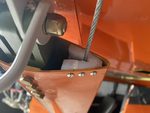Aircraft assembly
Fuel flow testing was the main goal today. It turned into a long exercise. In short, all fuel flows exceeded the requirements by a large margin. Left and right tanks when selected individually showed flows of 129 LPH and 132 LPH. In BOTH the flow rate was 150 LPH. We checked flow rates with the electric fuel pump on and off, fuel caps on and off, tail low, cruise attitude, nose very low, etc, and any combination we could think of. We also ran a tank very low, unported the fron fuel line, turned the pump on, and tried to suck air. However it kept pumping fuel right to the end.
One issue had us scratching our heads. When a tank was completely empty, if we added 5-10 liters, no fuel would come out. If we selected another tank, or BOTH, or turned the pump on, then selected back to the original tank, the problem would resolve immediately back to normal flow. We repeated this scenario at least 10 times, and on both L&R tanks. However it is very unlikely to be of any consequence because it's highly unlikely that a tank will ever be completely empty. And if it is, it's unlikely that only 5-10 liters with be added. Even then, in both, the problem didn't occur. We think that when first adding fuel to a dry tank an air lock is forming until enough head pressure is present to overcome it, or additional pressure or venting is present.
This appeared to occur in a short part of the fuel line I have between the electric pump and the fuel flow transducer. This runs uphill when on the groumd. It may be specific to my installation. However, once a flow was established, it always flowed again after multiple fuel Selector positions.
We also discovered that the right sight gauge has a small leak.


